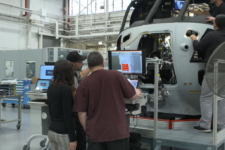 Bill Greenwalt, former deputy undersecretary of Defense for industrial policy and longtime Republican acquisition expert on the Senate Armed Services Committee, has spent his career working acquisition and industrial base issues. So today’s debate about DoD acquisition reform to allow more rapid innovation is by far from his first rodeo. And, he says, plus ça change.
Bill Greenwalt, former deputy undersecretary of Defense for industrial policy and longtime Republican acquisition expert on the Senate Armed Services Committee, has spent his career working acquisition and industrial base issues. So today’s debate about DoD acquisition reform to allow more rapid innovation is by far from his first rodeo. And, he says, plus ça change.
Another year gone, and if there is one solid prediction to be made for 2020 it is that questions will be raised about the effectiveness of the defense acquisition system and debate will continue over what types of “reforms” are needed. One of the most critical challenges facing the US is whether the acquisition process is nimble enough to adjust to the continuous and rapid advancements in information technology (IT) – today manifesting itself in the promises of artificial intelligence, autonomy, robotics and data analytics.
In the waning months of 2019 there were a number of acquisition reform anniversaries that went largely unnoticed and unrecognized. Each was significant in the development of our current acquisition system’s approach to previous rounds of IT innovation. The results of these efforts were mixed and offer lessons learned as the US begins to compete with a China that has readily embraced civil-military fusion of its industrial base and has few of the acquisition process challenges that DoD endures.
It has been a little over 25 years since the signing into law of the Federal Acquisition Streamlining Act (FASA) that established the foundations of commercial item procurement or Federal Acquisition Regulation (FAR) Part 12. It has also been a quarter of a century since the issuance of a staff report conducted for then Sen. William Cohen entitled “Computer Chaos” that I was fortunate enough to work on. This report set the stage for the Clinger-Cohen Act (CCA) of 1996 that expanded FASA’s commercial item reforms, but also outlined the need to develop IT incrementally and avoid large government unique software intensive projects.
Finally, it was 30 years ago that Congress granted DoD Other Transactions Authority (OTA). This authority, modified over the decades, has its origins in earlier efforts whenever Congress sought to bypass the rigid traditional contracting system to spur on innovation, such as in the 1920s when experimental authority was used for aircraft development and in the Sputnik era with the 1958 Space Act. FASA, CCA and OTAs re-set the foundation for how the US government could buy and use information technology and the subsequent implementation successes and failures illustrate the challenges DoD faces as it continues to adjust to the information age.
One problem was largely solved through these efforts. In the mid-1980s, the Packard Commission recognized that commercial products, primarily at the time computer hardware, were better and cheaper than military counterparts and it was impossible for the government to purchase them in a timely manner. Government-unique specifications and contracting requirements created barriers to the ability to buy items one could get at Best Buy or Walmart, forcing the government to rely on unique and more expensive items developed just for the government market. FASA, CCA and DoD leadership under Secretary Bill Perry were largely successful in removing the barriers to using readily available commercial off the shelf products, or COTS. The days of DoD’s infamous chocolate chip cookie specification and other reinventions of COTS products were thankfully over. Armed with a government credit card, the world of the American consumer was opened up to DoD and the amount of FAR Part 12 contracting soared to over $60 billion a year.
In retrospect, this was only a partial victory. While DoD no longer had to take four years to purchase computer hardware that would then be several generations out of date, it still continued to lag the commercial market in areas where one is not buying a physical good — such as cloud computing, IT services or software design.
Even worse, and despite provisions in FASA and CCA to the contrary, DoD has not been able to lead and proactively work with the commercial market on defense solutions that have commercial applications. Information security is the most glaring example of this lost leadership opportunity. Leading requires incentivizing commercial industry to innovate on the government’s behalf rather than just sell the same product it does to Ford or General Electric. It has not been a lack of companies willing to do this and work on hard defense problems, but seeing what non-traditional commercial companies such as SpaceX, 3M, Palantir, AGI and now Anduril have faced in process and bureaucratic barriers it is no wonder most have given up.
The inability of DoD to tailor its processes to incentivize non-traditional participation in the market has serious national security implications. One of the most significant underlying causes relates to pricing, and it is here where the contracting and oversight communities have failed DoD and the nation. COTS products are easy to price, as there is a market out there to make comparisons for identical items. The problem arises once a new, bespoke, similar or modified commercial solution could be offered, as the government does not know how to price its value. It only knows how to get to its definition of a fair and reasonable price for something that it has not bought previously (or is not COTS) through the rigorous application of either a cost-type contract or by using on a variety of fixed-price type contracts the Truth in Negotiations Act’s (TINA) requirements that force collection of unique non-commercial cost and pricing data. Commercial companies have refused to enter into such contracts and invest in expensive non-commercial TINA compliant accounting systems for a customer who might only make up a small percentage of its sales.
Congress in FASA was prescient in trying to incentivize the incorporation of commercial innovation by exempting commercial items from TINA, and creating a separate category of commercial items called commercial of a type that allowed for commercial contractors to innovate on the government’s behalf rather than just sell identical commercial products. One of the biggest failures of FAR 12 contracting has been DoD’s unwillingness to proactively use these commercial of a type procedures because of its inability or cultural aversion to pricing value. This has led to the absurd situation of DoD again spending billions of dollars a year to try and reinvent commercial capabilities with defense unique contractors sometimes at 10 times the cost (but at fixed profit rates).

Bill Greenwalt
Even worse, if DoD were lucky enough at the end of this reinvention process to get anything out of the expense, it would have less capability than what it could have bought years ago. Using the canard that ‘commercial of a type’ solutions lead to “excess profits”, the DoD IG has placed itself as the gatekeeper to police any deviance from collecting cost and pricing information rather then developing a workable alternative value or non-TINA price based criteria. In the meantime commercial contractors are taking their better than defense solutions elsewhere, to include overseas.
The failure of the commercial of a type model has made OTAs more important, as this may now be the only way to get non-traditional companies to work on DoD unique solutions. However, the contracting and oversight communities inherent risk averseness is threatening the flexibility in the OTA model, just as they have destroyed FAR 12 as a means to access and incentivize commercial innovation.
One measure of this destruction is to look at the evolution of contracting clause creep. What once in the 1990s were just a few government unique contracting clauses applied to FAR 12 commercial type contracts now registers in the hundreds. Compliance with these non-commercial clauses makes even COTS contractors hesitant to sell to the DoD except through third party resellers. FAR 12 contracts now look more like FAR 15 traditional contacts, and solutions that once should have been purchased through FAR 12 contracts are now attempting to migrate to OTAs.
So the answer should be to fix FAR 12 and streamline the number of unnecessary contracting clauses, right? No, now the contracting mafia is starting to load up OTAs with their own set of government-unique contracting clauses taken directly from the FAR. While not OTAs, nowhere is this trend better illustrated than in the Air Force’s so-called 1-page Small Business Innovation Research (SBIR) contracts that are plagued by 80 pages of specific FAR contract clauses incorporated by reference. Venture capital backers of small companies winning SBIR contracts are only now realizing what they are signing up to. The likely result will be the limited participation by these types of companies in the defense market in the future.
What is the problem? Isn’t oversight and transparency good? Sure, if those measures add real value and do not come at the cost of innovation by restricting the industrial base willing to work with DoD. Those scales tipped the wrong way decades ago, and DoD continues to be saddled with paying billions more today on less capable systems. As there will always be someone willing to take DoD’s money, the Department becomes oblivious to what is out there in the real market and dismissive of those who choose not to bid.
The question that should continue to be asked is whether DoD is accessing the best technologies, scientists and engineers in the free world to work on its problems, and unfortunately the evidence has been pointing toward the negative since the 1980s. As much of that capability (particularly for IT) now exists in the commercial market, without effective commercial contracting methods the default is to try and double down on defense-unique solutions with a defense-unique industrial base. That may not matter if the US was still technologically dominant with regards to its potential adversaries. But, that premise is now questionable and the contracting and oversight community need to be persuaded to adjust methods or China will dominate in artificial intelligence and other technologies. DoD will not be able to afford nor access the types of innovation and solutions it needs from a wider set of players beyond just the traditional cost-plus contractors.
If I were to write “Computer Chaos” today, I would be struck by how much hasn’t changed. A plethora of recent GAO reports could be mined that describe failed large grand-design IT programs with traditional contractors. The recent Defense Innovation Board’s Software Acquisition Practices study describes a world far removed from commercial best practices. Many of the findings and conclusions made 25 years ago about not leveraging commercial solutions would unfortunately remain the same. Despite some progress and Congress giving DOD broad acquisition authorities, “Computer Chaos” still reigns supreme. But unlike 25 years ago, the consequences of that chaos are far more problematic.
Sullivan: Defense industry ‘still underestimating’ global need for munitions
National Security Advisor Jake Sullivan said that there are “no plans” for another Ukraine supplemental at this point.


























